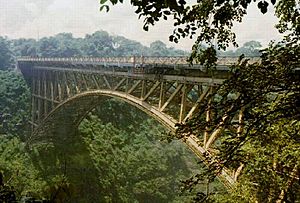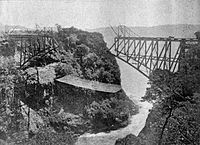Victoria Falls Bridge facts for kids
Quick facts for kids Victoria Falls Bridge |
|
|---|---|
 |
|
| Carries | road, rail, foot traffic |
| Crosses | Zambezi River |
| Locale | Second Gorge of Victoria Falls, crossing the Zimbabwe-Zambia border |
| Maintained by | national railways of Zimbabwe and Zambia |
| Characteristics | |
| Design | Parabolic arch |
| Material | Steel |
| Total length | 198 metres (650 ft) |
| Height | 128 metres (420 ft) |
| Longest span | 156.5 metres (513 ft) |
| Number of spans | 1 |
| Piers in water | 0 |
| History | |
| Designer | G. A. Hobson |
| Construction begin | 1904 |
| Construction end | 1905 |
The Victoria Falls Bridge crosses the Zambezi River just below the Victoria Falls and is built over the Second Gorge of the falls. The river is the border between Zimbabwe and Zambia. The bridge has border posts on both ends, at the towns of Victoria Falls, Zimbabwe and Livingstone, Zambia.
Contents
History
The bridge was the idea of Cecil Rhodes. It was part of his grand plan to build a railway from Cape Town to Cairo. He never visited the falls and died before the building of the bridge began. Rhodes told the engineers to "build the bridge across the Zambezi where the trains, as they pass, will catch the spray of the Falls". It was designed by George Anthony Hobson, of consultants Sir Douglas Fox and Partners, not as is often stated, Sir Ralph Freeman, the same engineer who designed the Sydney Harbour Bridge. Freeman, who also worked for Sir Douglas Fox and Partners, did the calculation of stresses for the bridge.
The bridge was built in England by the Cleveland Bridge & Engineering Company. It was then shipped to the Mozambique port of Beira and transported on the newly built railway to the Victoria Falls. It took just 14 months to put together and was completed in 1905.
The bridge was officially opened by Professor George Darwin, son of Charles Darwin, and President of the British Association (now the Royal Society) on 12 September 1905. The American Society of Civil Engineers lists the bridge as a Historic Civil Engineering Landmark.
Made from steel, the bridge is 198 metres (650 ft) long, with a main arch spanning 156.50 metres (513.5 ft). It is 128 metres (420 ft) above the lower water level of the river in the gorge below. It carries a road, railway and footway. The bridge is the only rail link between Zambia and Zimbabwe, and one of only three road links between the two countries. The other road links are at Chirundu Bridge and Kariba Dam.
The Victoria Falls Bridge did not bring the first train or the first railway to Zambia. In order build the railway north as fast as possible, Cecil Rhodes wanted the Livingstone to Kalomo line built before the bridge was finished. A locomotive was carried in pieces across the gorge by the temporary electronic cableway used to carry the bridge materials. The cableway was called the 'Blondin' by the bridge engineers. The locomotive was put back together and started work months before the bridge was complete.
For more than 50 years the bridge was used by passenger trains as part of the main route between the then Northern Rhodesia, southern Africa and Europe. Freight trains carried mainly copper ore (later, copper ingots) and timber out of Zambia, and coal into the country.
The age of the bridge and maintenance problems have led to traffic restrictions at times. Trains cross at less than walking pace and trucks were limited to loads of 30 tons. Bigger trucks have to take the longer road using the Kazungula Ferry or Chirundu Bridge. The limit was raised after repairs in 2006. The bridge needs to be extensively rebuilt or replaced.
During the Rhodesian UDI crisis and Bush War the bridge was often closed (and regular passenger services have not been successful). In 1975, the bridge was the site of unsuccessful peace talks when the parties met in a train carriage above the gorge for nine and a half hours. In 1980 freight and road services restarted and have continued without interruption except for maintenance.
Today one of the Victoria Falls Bridge's main attraction are historical guided tours about the construction of the bridge and which include a walking tour under the main deck. On the Zambian side there is a small museum about the bridge which is free to enter and contains cafe selling refreshments. Also located on the bridge is the Shearwater 111 metres (364 ft) bungee jump including a bungee swing and zip-line. Concerns about safety of the attraction were raised in late 2011 after the bungee's cord snapped and a young Australian woman fell 24 metres (79 ft) into the fast flowing river with many crocodiles.
The bridge was originally called the Great Zambesi or Zambezi bridge, later becoming known as the Victoria Falls Bridge.
Map
The Location of the bridge and surrounding area by Openstreetmap
Gallery
Images for kids
See also
 In Spanish: Puente de las Cataratas Victoria para niños
In Spanish: Puente de las Cataratas Victoria para niños







